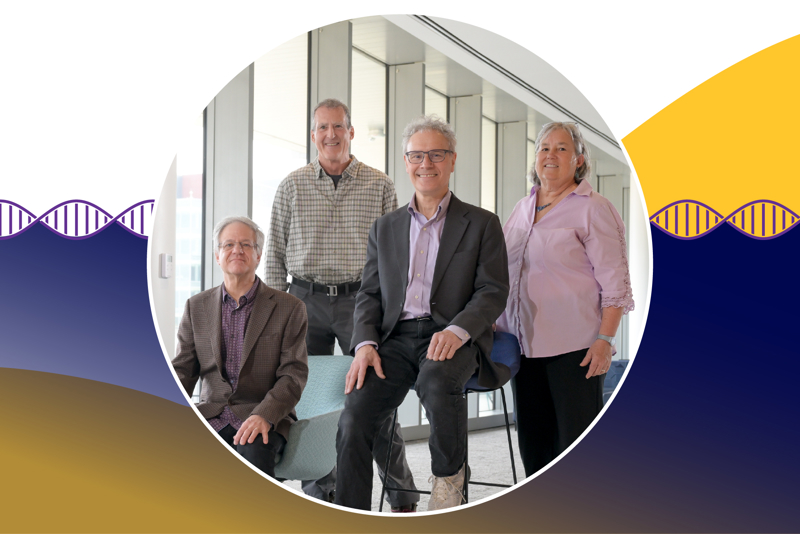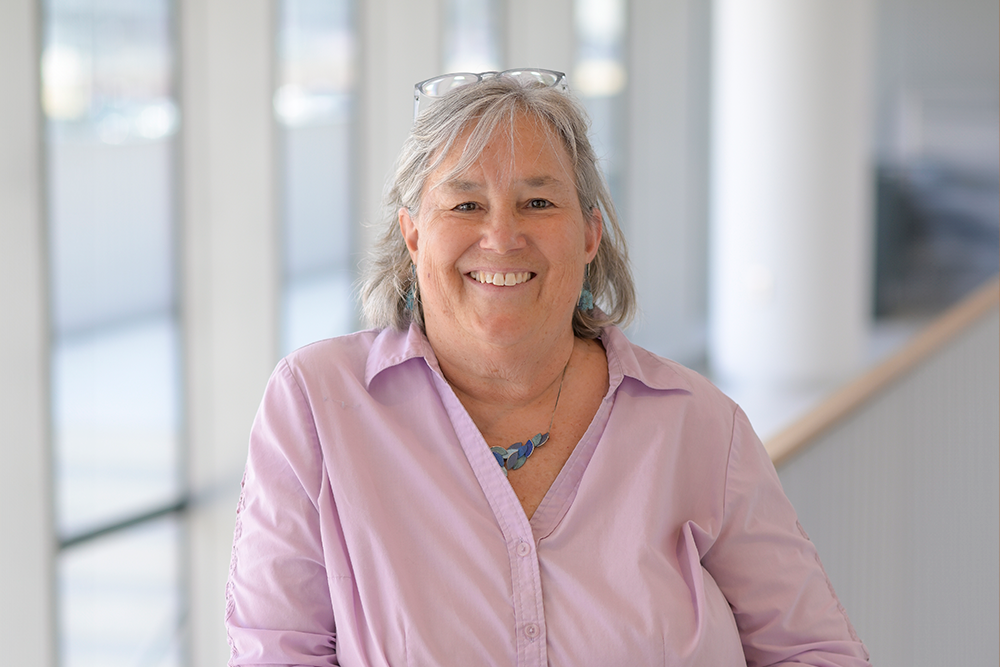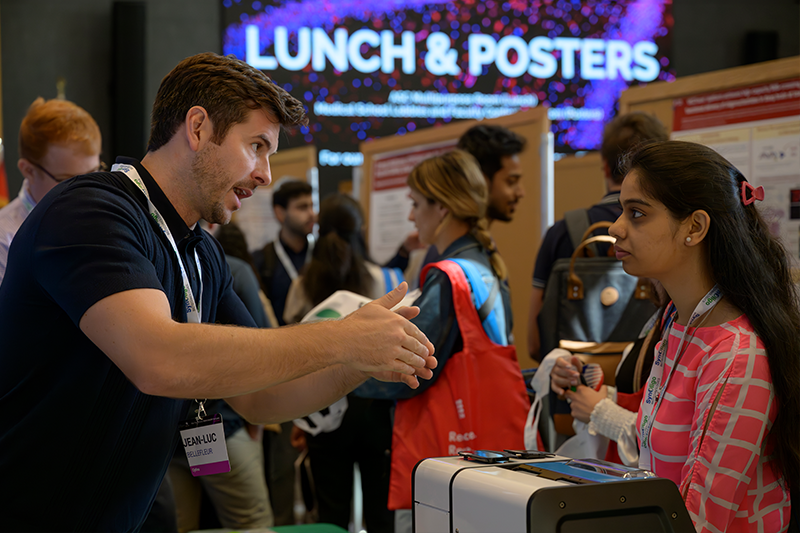A culture of curiosity
RNA Therapeutics Institute fosters creativity leading to biomedical breakthroughs
By Susan E.W. Spencer

RNA Therapeutics Institute founding co-directors Phil Zamore, PhD, Craig Mello, PhD, Victor Ambros, PhD, and Melissa Moore, PhD.
(Photo: Faith Ninivaggi)
Before the roll out of COVID-19 vaccines, many people were not familiar with RNA, much less messenger RNA that powered the pandemic-ending shots. But today, many RNA-based therapies are in clinical trials for debilitating diseases such as Huntington’s, Parkinson’s and preeclampsia. Much of the research that spawned these potentially lifesaving treatments grew out of work done by scientists at UMass Chan Medical School’s RNA Therapeutics Institute (RTI).
So how did a young institute in Central Massachusetts, at a relatively young medical school, become a global hub of RNA research, with two of its four founding co-directors being Nobel laureates?
“What’s unique about this place is not that we hired a bunch of RNA people. It’s that we hired people into an environment that was a microcosm of the larger UMass Chan ethos,” said Phillip D. Zamore, PhD, Howard Hughes Medical Institute Investigator, the Gretchen Stone Cook Chair in Biomedical Sciences, and chair and professor of RNA therapeutics. “That can’t be replicated without having the right culture and the investment in bringing people together.”
The stellar scientists who formed the RTI established it as a place that combined basic research and translation of scientific discoveries into medical therapies in a way not seen at other institutions, according to Dr. Zamore. The core of the RTI’s success stems from having faculty, postdoctoral researchers and students collaborate and inspire each other, leading to unexpected discoveries that can shape the future of a field.
“People paid attention to the larger medical schools, and so we needed to work together to stay on top.”
“It wasn’t serendipity, and it wasn’t by design. It is, I think, one of the small number of possibilities that can happen when you hire smart people into environments with too little money,” said Zamore. “Once individuals can do everything they want alone, what is the incentive to collaborate?”
Since its early days, the RTI and UMass Chan have grown to attract a large amount of federal funding, private grants and philanthropy. The institution now ranks near the top among public medical schools in the Northeast in funding awarded by the National Institutes of Health.
While resources have expanded, Zamore and others in the department said the culture thrives because it is so valued.
“It was RNA nirvana,” said Melissa J. Moore, PhD, professor of RNA therapeutics and former co-director of the RTI. “Not only did you have this incredible strength in RNA, but this incredibly collaborative culture. A lot of that, I think, came out of the fact that we were a relatively new kid on the block. People paid attention to the larger medical schools, and so we needed to work together to stay on top.”
Dr. Moore, who was a Howard Hughes Medical Institute Investigator, joined UMass Chan in 2007 and left full-time academic life in 2016 to become chief scientific officer at Moderna, producer of one of the first COVID vaccines. She is now retired but consults with biopharmaceutical companies making RNA therapies.

(Photo: Faith Ninivaggi)
Genesis of the RTI
UMass Chan’s growth in RNA biology and therapeutics took off after Craig C. Mello, PhD, the Blais University Chair in Molecular Medicine, was awarded the 2006 Nobel Prize in Physiology or Medicine for his pioneering research on RNA interference (RNAi), in collaboration with Andrew Fire, PhD, of Stanford University.
In addition to recognizing the broad implications of RNAi for the treatment of diseases, the award brought significant investment by the state into its public medical school, including funding for the Albert C. Sherman Center.
The focus on expanding RNA biology and development of therapeutics became a centerpiece of UMass Chan’s new administration, after Terence R. Flotte, MD, the Celia and Isaac Haidak Professor, executive deputy chancellor, provost and dean of the T.H. Chan School of Medicine, came to the Medical School in 2007, the same year Michael F. Collins, MD, professor of population & quantitative health sciences and medicine, was named chancellor.
The RTI, officially launched in 2009, was led by four co-directors who rotated duties: Zamore, Mello, Moore and Victor R. Ambros, PhD, who also came to UMass Chan in 2007. Dr. Ambros, the Silverman Chair in Natural Sciences and professor of molecular medicine, was awarded the 2024 Nobel Prize in Physiology or Medicine for his co-discovery of microRNA with Gary Ruvkun, PhD, of Harvard Medical School.
According to Moore, the institute’s initial name was the RNAi Therapeutics Institute. She pushed to drop the ‘i’ because investigators were exploring a wider range of RNA mechanisms, all which control gene expression. In addition to the small RNAi (siRNA), there were microRNA, which Drs. Ambros and Ruvkun discovered, and mRNA, which contain the blueprint for proteins.
“You can think of them as yin and yang,” Moore said. “Messenger RNA therapeutics enable us to tell the body to make more of a certain protein or new protein, whereas siRNAs and microRNAs tell the body to make less of a particular protein.”
Central to the ethos of the RTI is the shared conviction that both basic science and translational research are vital in developing effective medicines.
“There’s still a lot of unexplored stuff in the RNA field that we don’t understand,” said Moore. “It’s extremely important to continue basic curiosity-driven research, like, just how does this work? Once we have that basic knowledge, we can engineer things to make medicine.”
A Nobel breakthrough
When Mello was recruited to UMass Chan in 1993 to be part of the Cancer Center, he said he “took a chance and never looked back.”
It was here that Mello, working with C. elegans in what he described as the Medical School’s first worm lab, discovered with Dr. Fire RNAi-gene silencing by double-stranded RNA, leading to the Nobel Prize. His lab’s work also linked directly to Ambros’ and Ruvkun’s work on microRNA pathways in C. elegans, showing they were genetically and biochemically related.
“The excitement at the time was that we might be able to make drugs where we could essentially artificially program the system,” said Mello. “You could easily imagine a therapeutic where you design it to inactivate a gene that causes pathology in a human.”
With Zamore having joined the small but preeminent cadre of RNA scientists at UMass Chan in 1999 and the catalyst of a 10-year, $1 billion statewide commitment from Gov. Deval Patrick’s Life Sciences Initiative following Mello’s Nobel award in 2006, Mello said they wanted to build on the existing RNA expertise and recruit others to create the RNA Therapeutics Institute. High on the list of recruits were Ambros and Moore.
Speaking for myself, I certainly felt like a charlatan, because of course there were no RNA therapeutics at all at that time,” Mello said.
Mello credited UMass Chan’s leadership, along with scientific expertise and culture, with helping to make the dream of RNA therapeutics a reality. They brought together genomics, genetics, systems biology, bioinformatics and gene therapy researchers into one building so they could mix together.
“I guess you can say we built on our strengths, but we didn’t just build on them, we created synergy,” said Mello. “Somehow we have been able to encourage that intermixing, that synergy, that’s made it great.”
Expanding RTI's reach
In 2009, Andrei A. Korostelev, PhD was wrapping up his postdoctoral work at University of California Santa Cruz, focusing on translation mechanisms of ribosomes, which are responsible for decoding genetic information and synthesizing proteins in all living organisms. He saw an advertisement for the new RNA Therapeutics Institute forming at UMass Chan, with four co-directors—Mello, Zamore, Ambros and Moore—all luminaries in the field.
“When I realized that these four people are actually in the same place, I thought I should look it up,” said Dr. Korostelev, now professor of RNA therapeutics, who became the RTI’s first hired principal investigator.
“I thought that it was going to be somewhat intimidating for me to meet all these people, but instead, it immediately felt that I belong here, because it was all about science, it was all about excitement, and it felt like this is the place where the next big things are going to happen,” he said.
“I had several interviews at other places, so I remember vividly how I called my wife in the evening after the RTI interview and said this is something special.”
The support from UMass Chan administrators was also praised by Korostelev, who pointed out that it was after listening to investigators that the Medical School became the first research institution in New England to set up a highresolution electron microscope, a costly but crucial piece of equipment for zooming in on the atomic structures of cellular molecules.
Korostelev said that although the department is a therapeutics institute, he was always encouraged to work on his basic science. And in so doing, he has developed interesting ideas about therapeutics that he believes wouldn’t have happened elsewhere. He recently published one of those approaches that has the potential to treat several hundred diseases.
“I like to say that when I interviewed and when I arrived, I suspected that it’s too good to be true,” Korostelev said of the RTI. “I thought that there must be some skeletons in the closet that I will probably discover. So, it’s been 14 years and I’m still looking.”
Lessons in chemistry
By 2011, with burgeoning developments coming out of the RTI, the directors were looking to add someone with expertise in translating technical scientific ideas into drugs. Anastasia Khvorova, PhD, had previously collaborated with several of the RTI’s senior investigators while working in the biotechnology field. She was recruited to UMass Chan to start the Nucleic Acid Chemistry Center, the only nonprofit facility in North America capable of gram-scale synthesis of modified oligonucleotides.
“If you want to be serious about RNA therapeutics, you have to be able to make it correctly,” said Dr. Khvorova, the Remondi Family Chair in Biomedical Research and professor of RNA therapeutics. “The process for making RNA or DNA or oligonucleotides requires a lot of chemical engineering and a lot of equipment.”
“A lot of the world is paying attention to what’s happening here. I don’t think the Nobel Committee is done with us yet.”
Khvorova continues to collaborate with colleagues on bringing RNA therapeutics to clinical trials, co-founding or serving as an advisor to several biotech companies. Among the companies that grew out of research from the RTI are Comanche Biopharma, maker of an RNA therapeutic for preeclampsia; Atalanta Therapeutics, deploying RNAi to treat neurodegenerative diseases; and Alys Pharmaceuticals, which aims to redefine therapy for immune-dermatology conditions such as vitiligo and alopecia areata.
These companies build on earlier biotech developments from the RTI, notably Alnylam Pharmaceuticals, co-founded in 2002 by Zamore. In 2018, Alnylam announced the first-ever FDA approval of an RNAi therapeutic for the treatment of a rare, inherited, rapidly progressive and life-threatening adult disease with a constellation of manifestations.

Dr. Mello is the Blais University Chair in Molecular Medicine.
(Photo: Faith Ninivaggi)
“Chemistry is essential,” said Khvorova. And by chemistry, she means not only the scientific field, but also the interconnection between people and the community.
“You have a list of faculty here in which each one of them is a star, and they can have labs anywhere they want, but they choose to be here,” she said. “It’s clearly a chemistry between faculty, but it’s also continuous support from the dean and chancellor, and we are very lucky with Phil (Zamore) as department chair. He has enormous charisma, and he cares, and I think that really matters.”
The RTI’s success has contributed greatly to the success of UMass Chan, according to Khvorova; and success of the Medical School profoundly contributed to the birth of the biotech industry in Worcester and the region’s overall economic development.
Engineering the future
The RTI isn’t finished growing yet.
Zamore highlighted his vision for the future, which would include rolling out a graduate program in RNA biology and a service requirement for graduate students, such as Science Learning with Interactive Virtual Education (ScienceLIVE), an online education outreach program for middle school-age students developed by the RTI. “Just like medical students, they have to engage with civil society, not just be tied to the lab,” he said.
The department is searching for its first Maraganore Early Independence Fellow, an exceptionally talented junior scientist who will develop an independent research program in RNA biology or RNA therapeutics.
Finding new sources of funding is a challenge for a lab that is beyond the start-up stage and faces deeper competition. Zamore said the department may have to re-envision how they structure resources.
“I have amazing colleagues. I’ve been here for 25 years because I’ve never had any desire to leave, and I feel very committed to helping ensure that we retain the things that are wonderful and that we fix the things that aren’t,” said Zamore.
Another aspect of the RTI is still ascending: “We’re definitely on the map. A lot of the world is paying attention to what’s happening here,” said Mello. “I don’t think the Nobel Committee is done with us yet.” ■
RNATx Symposium highlights research from concept to clinicRNATx Symposium, the annual conference hosted by UMass Chan’s RNA Therapeutics Institute, is the place to be in late June for the who’s who of RNA therapeutics. Since its launch in 2018, the symposium has drawn nearly 4,000 scientists, industry representatives, journalists, business developers and others. One hundred twenty-one speakers have presented, with participants coming from 272 biotechnology and pharmaceutical companies and 275 academic institutions, representing 45 countries. 
(Photo: Faith Ninivaggi) “Our keynotes each year have really moved the needle in some form or fashion within the RNA field,” said Angela F. Messmer-Blust, PhD, associate professor of RNA therapeutics, senior scientific advisor and co-organizer of RNATx. Last year, Jennifer A. Doudna, PhD, who shared the Nobel Prize in Chemistry in 2020 with Emmanuelle Charpentier, PhD, for their pioneering work using CRISPR/Cas9 gene editing, was a keynote speaker. Other featured Nobel laureates have included UMass Chan’s Craig C. Mello, PhD, the Blais University Chair in Molecular Medicine and distinguished professor of RNA therapeutics; and Victor R. Ambros, PhD, the Silverman Chair in Natural Sciences and professor of molecular medicine, who spoke along with his Nobel co-recipient, Gary B. Ruvkun, PhD, of Harvard Medical School. Katalin Karikó, PhD, from Szeged University in Hungary, and Phillip Sharp, PhD, of Massachusetts Institute of Technology, also presented keynotes. Keynote speakers at this year’s RNATx, to be held June 25-27, are V. Narry Kim, PhD, founding director of the Center for RNA Research, Institute for Basic Science at Seoul National University in South Korea; and Muthiah (Mano) Manoharan, PhD, senior vice president of drug innovation and distinguished research scientist at Alnylam Pharmaceuticals. “We invite scientists from industry and academia because one of the hopes of our conference is forging new collaborations and ultimately accelerating RNA research,” said Dr. Messmer-Blust. “It is necessary for basic research to lay the groundwork for therapeutic development, and we are beginning to see this currently come to fruition with RNA therapeutics.” |